Journals
An Unusual Case of Bell’s Palsy After Removal of Impacted Third Molars
A B S T R A C T
Background and Overview: Bell’s Palsy is a rare complication of third molar surgery which can be alarming both for the patient and the surgeon.
Case Description: The patient was a 21-year-old female who presented for routine extractions of 1, 17 and 32 under IV sedation. The procedure was performed without complications. She reported back to the clinic two days later with a chief complaint of inability to close her left eye. On examination it was found that she had profound weakness of the front and zygomatic branches of the left facial nerve consistent with Bell’s Palsy. The patient was treated with steroids, antivirals and eye protection. The patient had full recovery of nerve function in approximately four weeks and suffered no complications.
Conclusion and Practical Implications: Bell’s Palsy is a rare complication of facial surgery and can afflict patients undergoing third molar extraction. The stress of surgery can lead to viral reactivation, causing swelling of the facial nerve as it course through the petrous portion of the temporal bone. Though rare, patients should be warned of the possibility of Bell’s Palsy in the preoperative period. Patients who suffer from Bell’s Palsy need to be reassured, given appropriate eye protection to include eye lubricant and eye patches and should be instructed on how to care for their eye while sleeping through taping. The literature supports the use of steroid therapy while the usefulness of antiviral medication remains controversial.
Keywords
Bell’s Palsy, third molar removal, complication
Background
Sir Charles Bell first described the motor function and anatomy of the 7th Cranial Nerve in the early 1800’s. The term “Bell’s Palsy” refers specifically to facial paralysis of unknown etiology, which represents about half of all cases of facial paralysis [1]. Bell’s Palsy presents with unilateral paralysis of the muscles of facial expression, with or without a prodrome of preauricular pain, tingling or numbness on the affected side. Herpes Simplex Virus, which after primary infection can lie latent within nerve ganglions, has been implicated in some cases of Bell’s Palsy. Triggering events can include infection, stress and trauma have been implicated, but the exact mechanism remains unknown. We describe a case of delayed, partial facial nerve paralysis in a patient after routine extraction of third molars.
Case Report
A 21-year-old ASA 1 female was evaluated for the removal of teeth numbers 1, 17 and 32 (third molars also known as wisdom teeth). The upper left third molar, tooth number 16, was not present. After discussing the risks, benefits and potential complications of the procedure and performing a focused history and physical, the patient elected for extraction under deep intravenous sedation in the a clinical setting. On the day of surgery, the history and physical was reviewed, the procedure confirmed and the consent was signed. The patient underwent IV sedation with blood pressure, etCO2, pulse oximetry and ECG monitors in place. The surgeon also used a precordial stethoscope. Anaesthesia was induced using Fentanyl, Versed and Propofol and all three third molars were surgically removed without complications. All sites were irrigated copiously with normal saline and closed with 3-0 Chromic gut suture.
Two days later, the patient called the clinic complaining of inability to close her left eye. She claimed that immediately after surgery she had no symptoms and her pain was well-controlled. The evening of the next day, she claims that her brother noticed that her left eye was not closing properly. Inspection in the mirror confirmed this and so she called the clinic the next morning. The patient was instructed to return to the clinic and she underwent a full physical examination to include intraoral, extraoral, and cranial nerve examination. All wounds were clean and closed without signs or symptoms of infection. She was appropriately swollen and there was no bleeding from any of the surgical sites. The cranial nerve exam revealed no V3 paresthesia or loss of taste with a House Brackman Grade IV weakness of the frontal branch of the left facial nerve and a Grade II weakness of the Zygomatic branch on the left side only. The patient was unable to close her left eye and there was loss of the nasolabial fold with an asymmetric smile in animation (Figures 1 & 2). The buccal, marginal mandibular and cervical branches on the left side were normal and the right side was completely unaffected.
Figure 1: Facial animation attempt at post-operative day 2 showing decreased function of the left facial nerve.
Figure 2: Photo showing the patient attempting to close her eyes at post-operative day 2 showing decreased function of the left facial nerve.
The patient’s medical history was reviewed with a focus on personal history of HSV or cold sores. The patient confirmed that she did have a history of cold sores, and that she often has profound breakouts of cold sores whenever she is under significant stress. We reassured the patient, gave her postoperative exercises to perform to help spur recovery and recommended a Vitamin B supplement. She was given instructions to purchase for eye lubricant, gauze, paper tape and an eyepatch to protect her eye and given instructions on how to apply them. She was also given prescriptions for Valacyclovir 500mg (2 tabs immediately and another 2 tabs 12 hours later) and Prednisone 10mg (60mg/day for 5 days, then taper down the dose by 10mg a day for five days). The patient was followed up at six days and showed some improvement (Figures 3-5). Her vision was intact and she had no pain from her extraction sites or her left eye. She was reassured and scheduled again two weeks later. At this follow up appointment it was noted that her nerve deficit was significantly improved from her initial presentation (Figures 6 & 7). Her left frontal nerve was graded at a House Brackman II and her Zygomatic branch was a House Brackman I. At her one month follow up the nerve deficit was almost completely resolved and at six weeks there was no evidence of nerve deficit in the distribution of the left facial nerve.
Figure 3: Facial animation at post-operative day 6 showing improving function of the left facial nerve.
Figure 4: Post-operative day 6 patient attempting to close her eyes.
Figure 5: Post-operative day 6 patient in animation.
Figure 6: Three weeks post-operative in animation showing continued improvement in left facial nerve function.
Figure 7: Three weeks post-operative showing her ability to close her eyes fully.
Discussion
The muscles that control facial expression are a key component to an individual’s sense of self and a chief mechanism on social interaction. Loss of these functions affects the ability to provide non-verbal cues, express emotions, and can be deleterious to the eyes through loss of corneal protection and blinking. The differential diagnosis for facial nerve paralysis is broad and includes idiopathic sources like Bell’s Palsy, infectious agents like Lyme disease and viral sources, tumors, trauma, cerebral infarct, pseudobulbar palsy, and development conditions. Facial muscle paralysis with intact upper third (forehead) movement need to be considered for a contralateral central/upper motor neuron lesion [2-5]. The Edinburgh facial palsy clinic surveyed over twenty-two thousand patients with facial palsy and over one-half reported a considered degree of psychological distress and restriction in social activities [3].
Of all these causes, one of the most common is Bell’s Palsy. Bell’s Palsy displays an equivalent distribution through all ages and sexes. It is more common in patients who are immunosuppressed, have diabetes mellitus, hypertension, are pregnant, and following an upper respiratory infection [2]. In the setting of local anesthetic there are two possible mechanisms for causing Bell’s Palsy, direct and indirect damage. Local anaesthesia is neurotoxic and if, during the course of standard dental injections, is injected too far posteriorly, could theoretically diffuse into the parotid gland and cause damage with paralysis to the facial nerve. Directly, the needle could also cause direct damage to a nerve if it penetrated and/or if the anesthetic was deposited within the neural sheath of the nerve [3]. Another suggested mechanism is compromise of the vascular supply causing ischaemia to the nerve, though this is unlikely to the redundant and robust nature of the facial vasculature. This could be mediated directly, or through an indirect mechanism whereby the breakdown products affect the sympathetic plexus of the external carotid artery, leading to a vasospasm of the facial nerve resulting in ischemic neuritis and edema [3, 6, 7].
What makes this case so unique and confounding is the lack of factors that could be pointed to as causative. The biggest factor is that the upper left 3rd molar, tooth number 16, was not surgically addressed, thus there was no trauma/insult to the area. There was only a lower inferior alveolar nerve (IAN) block done on the left side, and due to the anatomy, it is difficult to conceive how a properly performed IAN block, as evidenced by appropriate site anaesthesia during the surgery, would result in facial nerve paralysis. Direct damage from a needle is even less plausible than perhaps one of the aforementioned indirect mechanisms given the distance away from the facial nerve. Similarly, traction injury, more common during surgeries in the area of where the facial nerve exits the stylomastoid foramen and branches into the face such as parotidectomy, temporomandibular joint surgery, and approaches to the facial skeleton such as the retromandibular approach, is highly unlikely [6-9, 10].
There have been cases of Bell’s Palsy associated with infected third molars, hypothetically due to the local inflammatory response and swelling causing pressure on the nerve, though no infection was present with this patient [3-5]. The patient had no signs nor symptoms indicative of Lyme disease, caused by Borrelia Burgdorferi, which has been shown to cause facial paralysis with a predilection for children, and interestingly, bilaterally [2, 3, 11]. Inner ear issues can be a causative factor with condition such as otitis media and sources of inflammation and swelling causing compression of the nerve in the bony canal, however the ear exam and history on this patient was unremarkable. Tumors generally cause either episodic and/or multiple episodes of increasing nerve weakness, typically lasting four months or more. Given the case this cause was extremely unlikely with the presentation and relatively fast resolution [5].
The top two differential diagnoses in this case are viral and surgical stress. Herpesvirus can cause facial paralysis, if a rash and hearing loss are also present this constellation is called Ramsay Hunt Syndrome or herpes zoster oticus [12]. Reactivation of Herpesvirus within the geniculate ganglion itself is a proposed etiology for these patients. Serological testing by Adour and Hisinger on 41 patients with Bell’s Palsy showed all patients had antibodies to HSV indicating a recurring infection as opposed to a primary outbreak, supporting the hypothesis that it is an episode of reactivation of the virus causing an episode [4]. The facial nerve traverses the petrous portion of the temporal bone through the fallopian canal, which is approximately 33mm in length, and exits the skull from the stylomastoid foramen. There are three consecutive segments: the labyrinthine, the tympanic and the mastoid. The labyrinthine segment is the narrowest portion, with an average diameter of 0.68mm. It is thought that reactivation will cause the facial nerve to swell, causing compression of the nerve and resulting in loss of motor function [2-4, 12-15].
There is often a prodromal phase associated with a viral outbreak. In these cases, it tends to manifest as pain in the mastoid region, paresthesia is the affected areas, ipsilateral alterations in taste (if chorda tympani is involved), and generalized jaw pain mimicking an odontogenic source of pain [3, 6-8, 12]. Given the patients history of Herpes, this makes a viral etiology, possibly even brought on by surgical stressors, a likely etiology. The other most likely etiology is as a result of the surgery itself. However, this is the aspect that most confounded the surgical team, given it occurred in the area that was not operated in. It would have been much more likely to happen on the right side where a tooth was extracted, and one could extrapolate post-surgical swelling and inflammation or surgical traction with a nerve injury.
Treatment of Bell’s Palsy consists of eye protection and oral steroids with or without anti-viral treatment. An eye patch at night is useful to prevent corneal abrasion and excessive drying with the use of gel eye lubricant. During the day, eye drops and eye lubricant can be useful to provide patient comfort. Oral steroids to reduce inflammation of the facial nerve has been shown to be effective. Hato and Yamada advocated the use of antivirals with steroids in a large multi-center study of patients with Bell’s Palsy [16, 17]. This study was challenged by the Scottish Bell’s Palsy Trial, which concluded that the addition of antiviral medication to a regimen of eye protection and steroids was not supported by current evidence [18-20].
When one is facing a facial paralysis issue, it is important to consider all the possible etiologies and treat accordingly. We treated our patient with oral steroids and anti-viral medication to shorten the duration of a viral cause due to the strong history of HSV. Whether or not anti-viral medication made any difference in this case is impossible to say due to the fact that there was no control for comparison. Eye care must be focused on protection with proper lubrication and any taping measures as needed. Close clinical follow up is recommended as is early referral to a specialist if there is questions about cause and/or lack of early improvement.
Disclaimer
The views expressed herein are those of the authors and do not reflect the official policy of the Department of the Army, Department of Defense, or the U.S. government.
Disclosure
None.
Article Info
Article Type
Case ReportPublication history
Received: Fri 19, Jun 2020Accepted: Sat 04, Jul 2020
Published: Wed 15, Jul 2020
Copyright
© 2023 Andrew Jenzer. This is an open-access article distributed under the terms of the Creative Commons Attribution License, which permits unrestricted use, distribution, and reproduction in any medium, provided the original author and source are credited. Hosting by Science Repository.DOI: 10.31487/j.DOBCR.2020.03.07
Author Info
Joseph W. Ivory Andrew Jenzer Katie Y Vargas
Corresponding Author
Andrew JenzerStaff Surgeon, Residency, Department of Oral and Maxillofacial Surgery, Eisenhower Army Medical Center, Augusta, Georgia, USA
Figures & Tables
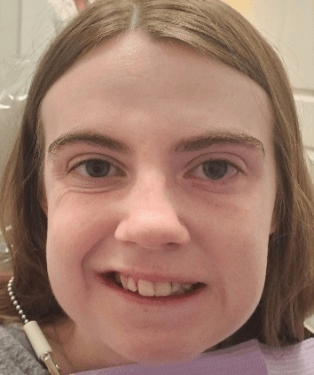
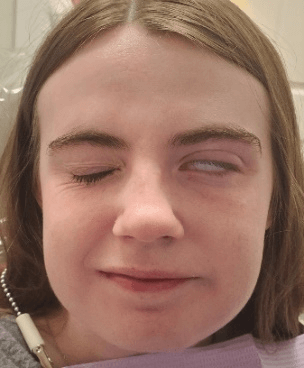
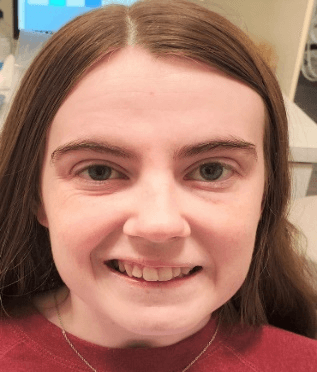
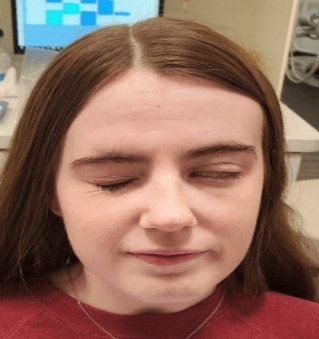
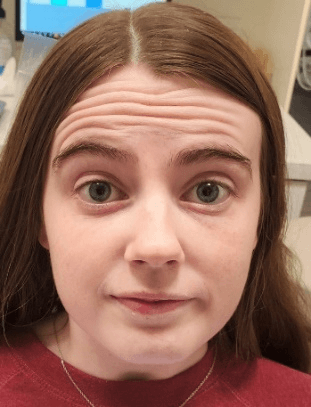
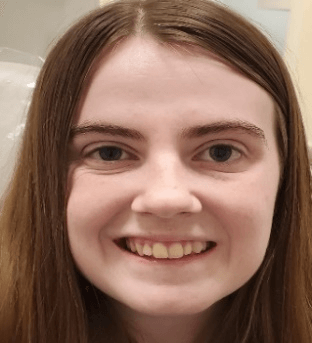
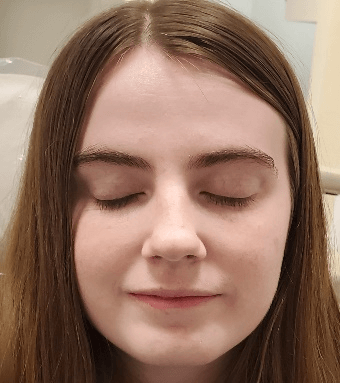
References
- M May, S R Klein (1991) Differential diagnosis of facial nerve palsy. Otolaryngol Clin North Am 24: 613. [Crossref]
- JP Leach, RJ Davenport (2018) Davidson’s Principles and Practice of Medicine; Neurology. Elsevier 25: 1061-1146.
- M Victor, AH Ropper (eds) (2001) Principles of Neurology (ed 7). New York, NY, McGraw-Hill.
- Jeffrey T Vrabec, Brandon Isaacson, James W Van Hook (2007) Bell’s palsy and pregnancy. Otolaryngol Head Neck Surg 137: 858-861. [Crossref]
- G C Cousin (2000) Facial nerve palsy following intra-oral surgery performed with local anaesthesia. J R Coll Surg Edinb 45: 330-333. [Crossref]
- Robert A Gaudin, Aaron K Remenschneider, Katie Phillips, Christian Knipfer, Ralf Smeets et al. (2017) Facial palsy after dental procedures - Is viral reactivation responsible? J Craniomaxillofac Surg 45: 71-75. [Crossref]
- Naoyuki Kanoh, Jun Nomura, Fumio Satomi (2005) Nocturnal Onset and Development of Facial Palsy. Laryngoscope 115: 99-100. [Crossref]
- K C Ling (1985) Peripheral facial nerve paralysis after local dental anesthesia. Oral Surg Oral Med Oral Pathol 60: 23-24. [Crossref]
- Fotios H Tzermpos, Alina Cocos, Matthaios Kleftogiannis, Marissa Zarakas, Ioannis Iatrou (2012) Transient Delayed Facial Nerve Palsy After Inferior Alveolar Nerve Block Anesthesia. Anesth Prog 59: 22-27. [Crossref]
- N Yanagihara, N Honda, N Hato, S Murakami (2000) Edematous swelling of the facial nerve in Bell's palsy. Acta Otolaryngol 120: 667-671. [Crossref]
- M Bitsori, E Galanakis, C E Papadakis, S Sbyrakis (2001) Facial nerve palsy associated with Rickettsia conorii infection. Arch Dis Child 85: 54-55. [Crossref]
- S Murakami, M Mizobuchi, Y Nakashiro, T Doi, N Hato et al. (1996) Bell palsy and herpes simplex virus: identification of viral DNA in endoneurial fluid and muscle. Ann Intern Med 124: 27-30. [Crossref]
- J LaBagnara Jr, A F Jahn, D V Habif Jr, E M Solomon (1989) MRI finding in two cases of acute facial paralysis. Otolaryngol Head Neck Surg 101: 562-565. [Crossref]
- K K Adour, D N Bell, R L Hilsinger Jr (1975) Herpes simplex virus in idiopathic facial paralysis (Bell palsy). JAMA 233: 527-530. [Crossref]
- AM Weir, B Pentland, A Crosswaite, J Murray, R Mountain (1995) Bell's palsy: The effect on self-image, mood state and social activity. Clin Rehabil 9: 121-125.
- JD Swartz, M Hagiwara (2011) Head and Neck Imaging, 5th Edition (Elzevier: Philedalphia, 2011), Chapter 18, 1183-1229.
- Naohito Hato, Hiroyuki Yamada, Hisashi Kohno, Shuichi Matsumoto, Nobumitsu Honda et al. (2007) Valacyclovir and Prednisolone Treatment for Bell's Palsy: A Multicenter, Randomized, Placebo-Controlled Study. Otol Neurotol 28: 408-413. [Crossref]
- Frank M Sullivan, Iain R C Swan, Peter T Donnan, Jillian M Morrison, Blair H Smith et al. (2007) Early treatment with prednisolone or acyclovir in Bell’s palsy. N Engl J Med 357: 1598-1607. [Crossref]
- Richard J Davenport, Frank Sullivan, Blair Smith, Jillian M Morrison, Brian McKinstry (2008) Treatment for Bell's palsy. Lancet 9645: 1219-1220.
- Frank M Sullivan, Iain R C Swan, Peter T Donnan, Jillian M Morrison, Blair H Smith et al. (2007) Early treatment with prednisolone or acyclovir in Bell’s palsy. N Engl J Med 357: 1598-1607. [Crossref]
- P L Bernsen (1993) Peripheral facial nerve paralysis after local upper dental anaesthesia. Eur Neurol 33: 90-91. [Crossref]
- Len Tolstunov, Gary A Belaga (2010) Bell’s palsy and dental infection: A case report and possible etiology. J Oral Maxillofac Surg 68: 1173-1178. [Crossref]
- M J Lanser, R K Jackler (1991) Gadolinium magnetic resonance imaging in Bell’s palsy. West J Med 154: 718-719. [Crossref]
- Donald H Gilden (2004) Clinical Practice. Bell’s palsy. N Engl J Med 351: 1323-1333. [Crossref]
- H Kohsyu, M Aoyagi, H Tojima, Y Tada, H Inamura et al. (1994) Facial nerve enhancement in Gd-MRI in patients with Bell’s palsy. Acta Otolaryngol Suppl 511: 165-169. [Crossref]
- N Kanoh, M Sakagami (1996) Impaired Ranvier node sodium‐potassium adenosine triphosphatase may induce facial palsy. Laryngoscope 106: 1180-1183. [Crossref]
